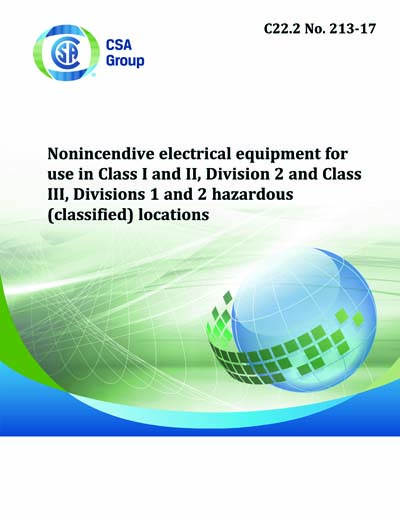Historical
CSA C22.2 No. 213-2017
Nonincendive electrical equipment for use in Class I and II, Division 2 and Class III, Divisions 1 and 2 hazardous (classified) locations (Binational standard with UL 121201)
Preface
This is the harmonized CSA Group and UL standard for Nonincendive Electrical Equipment for Use in Class I and II, Division 2 and Class III, Divisions 1 and 2 Hazardous (Classified) Locations. It is the Third edition of CSA-C22.2 No. 213 and the Ninth edition of UL 121201. This edition of CSA-C22.2 No. 213 supersedes the previous edition published in 2016. This edition of UL 121201 supersedes the previous ISA-12.12.01-2015 edition published on August 21, 2015.Scope
1.1 Introduction 1.1.1 The purpose of this standard is to provide minimum requirements for the design, construction, and marking of electrical equipment or parts of such equipment for use in Class I and Class II, Division 2 and Class III, Divisions 1 and 2 hazardous (classified) locations. 1.1.2 This equipment, in normal operation, is not capable of causing ignition of the surrounding atmosphere under the conditions prescribed in this standard, although the equipment may contain electronic components used in an incendive circuit and may also have field wiring that is an incendive circuit. 1.1.3 In addition, it is the intent of this document to establish uniformity in test methods for determining the suitability of the equipment and associated circuits and components as they relate to potential ignition of a specific flammable gas or vapour-in-air mixture, combustible dust, easily ignitable fibers, or flyings. 1.2 Applicable to Class I and II, Division 2 and Class III, Divisions 1 and 2 locations 1.2.1 This standard applies only to equipment, circuits, and components for use in Class I and II, Division 2 and Class III, Divisions 1 and 2 hazardous (classified) locations as defined in the National Electrical Code® (NEC®) ANSI/NFPA 70 or in the Canadian Electrical Code, Part I (CE Code, Part I) CSA C22.1. NOTE 1 Some equipment designed for use in unclassified locations is permitted by the NEC® or CE Code, Part I for installation in Division 2 locations. The judgment of acceptability for the installation would be determined by the authority having jurisdiction. Such equipment would not have the hazardous location marking or documentation described in this standard. It is anticipated that such equipment would comply with the other requirements in this standard and that the determination of compliance is elementary (e.g., a nonarcing instrument inside a Type 4 or Type 12 enclosure used in a Class II, Division 2 location). NOTE 2 Throughout this standard, references to CAN/CSA C22.2 No. 60079-0 and UL 60079-0 are made as CSA/UL 60079-0. Similarly references to CAN/CSA C22.2 No. 60079-1 and UL 60079-1 are made as CSA/UL 60079-1. Similarly references to CAN/CSA C22.2 No. 60079-11 and UL 60079-11 are made as CSA/UL 60079-11. Similarly references to CAN/CSA C22.2 No. 60079-15 and UL 60079-15 are made as CSA/UL 60079-15. NOTE 3 The US and Canadian adoptions of IEC 60079-0, IEC 60079-1, IEC 60079-6, IEC 60079-11, and IEC 60079-15 may be adopted at different revision levels and may have different National Deviations. 1.3 Applicable to associated nonincendive field wiring apparatus 1.3.1 This standard also applies to associated nonincendive field wiring apparatus located in a non-hazardous (unclassified) location specifically designed to directly connect to nonincendive field wiring in Class I and II, Division 2 and Class III, Divisions 1 and 2 hazardous (classified) locations. NOTE The 2015 CE Code, Part I does not address nonincendive field wiring circuits in Class II or Class III hazardous locations. 1.4 Applicable ambient conditions 1.4.1 The requirements of this standard are based on consideration of the following ambient conditions: a) a lower ambient temperature of -50°C or higher; b) an upper ambient temperature of 40 °C or lower; c) an oxygen concentration of not greater than 21 percent by volume; and d) a pressure of 80 kPa (0.8 bar) to 110 kPa (1.1 bar). NOTE Equipment specified for atmospheric conditions beyond the above limits may be subject to additional investigation. 1.5 Not applicable to specified ignition mechanisms 1.5.1 This standard is not applicable to mechanisms of ignition from external sources, such as static electricity or lightning, that are not related to the electrical characteristics of the equipment. 1.6 Not applicable to specific products 1.6.1 This standard does not apply to electric luminaires for use in Division 2 hazardous (classified) locations. 1.6.2 This standard does not apply to electric motors, electric heaters, heat tracing cables, and similar heat-producing products, except where they are an integral part of the equipment under evaluation, for use in Division 2 locations. Where electric motors, electric heaters, heat tracing cables, or similar heat-producing products are an integral part of the equipment under evaluation, applicable requirements from the Division 2 hazardous locations standards for these products shall be considered. 1.6.3 In the United States, this standard does not apply to battery-operated flashlights and lanterns within the scope of UL 783.CSA America, Inc. [csa]

